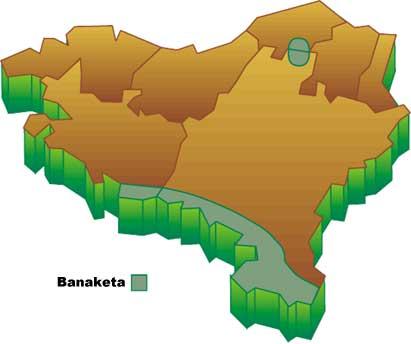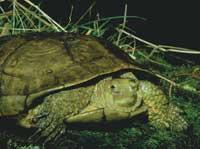The current tortoise, his bodyguard

Like other children, I was also given a small turtle, the day I turned six, if I'm not mistaken. That turtle called “Bixkor” carried it whenever we were going to play the river and once I left it badly tied I came out. “Lasai Miel Mari, who will appear,” my mother told me as she thought she would “give a great pake.” But “Bixkor” never appeared. What could that animal do? Who knows!

The truth is that until I started writing this article I never heard the name of tortoise, and the turtle told all the reptiles that had the back and belly wrapped in shell. If not! Freshwater turtles are called apoarmada and, although similar to turtles, have a molded body for water and are somewhat flattened shell. Both the Galapagos and the turtles are classified in the order of the kelonians, and as in the last 200 million years have survived on our planet, we can say that they have been very successful. But is there kelonium here? As we have seen, there may be some rare abandoned or loose specimen anywhere, but in addition to the exotic species, in these areas there are two species of Galapagos waterlogged ("Emys orbicularis") and the tortoise ("Mauremys leprose").
The contractile tortoise is a freshwater turtle of about 20 cm. As in the rest of the kelonians, this shell consists of bone plates covered with horn and tied to the vertebrae and spine ribs. This cover provides them with excellent defense against dangers and, to protect themselves from predators, they can hide the head and limbs inside the shell. In addition to these advantages, the inclusion in a rigid cover limits the movement capacity of the support and greatly exceeds the mobility of the neck.
Unlike the watered tortoise, the young stream has a clear keel in the shell and in the case of adults, in the back of the shell. Also, the presence of inginal plaques in the shell and the presence of erosions by many specimens, caused by some algae infection, are their characteristics. This disease causes in some cases the fall of some plaque, so in Spanish it is known as “leprosy”. On the other hand, they have a brown-greyish or green color almost without spots in the dorsal area and in the lower part of the horisca. Orange remains appear on the neck and forelegs.
As the name suggests, the corrosive tortoise lives in movable waters, but also in marshes and wells. A good hunter, though without teeth, uses the strong beak to detect fish, amphibians and aquatic invertebrates. It also feeds on fish and other dead carriages and occasionally riverside vegetation.

As is known, these reptiles are quite slow out of the water and are pulled from the front legs and pushed with those from behind. In the water, however, this march changes drastically. The use of long paddle legs, both in diving and diving, allows an unbeatable and vital movement. In addition, they have a quiet life and like to sunbathe calmly. Being slow, we might think that they often end up in the belly of predators, but it seems that, in addition to the human being, few enemies manage to overcome the protection of the shell. In addition, when an enemy incites it can spill a stream of filthy anal smells to leave him alone.
In early spring males approach females and pair in water. Although the rigid body for this task does not facilitate much, the lower part of the male shell is usually slightly concave in order to climb the dorsal meeting of the female. In late spring or summer, the female makes a hole on the river bank with strong leg barks, where she lays 5-10 eggs. Then carefully cover the broom with soil and finish with it the reproductive work of the parents. The eggs are incubated underground and, after a month, with their bulging at the tip, the pups of 5-6 grams of weight and about 3 cm in length break the eggshell. These will have to unassisted from the moment of their integration.
They are animals of long survival. It has been observed that only some can turn 70, but the average is very lower, around 25. However, throughout the year they can stand for long periods. During the winter it is normal to keep in the mud and in times of drought can adopt a similar behavior.

As for its distribution, the current tortoise is a Mediterranean species. It lives in much of the Iberian Peninsula and also ex-Jugoslabia and south of Bulgaria, northwest Africa and southwest Asia. As for its distribution in Euskal Herria, we know little. There are few confirmed appointments and some of them belong to human areas such as Pamplona. Given the need for extreme caution in these types of cases (which may be in favor or released), experts consider that local populations of the current tortoise are in two places: Around the river Ebro and in an area between Navarre and Lapurdi. This second may be surprising for its location in the Cantabrian area, but it is also a temperate and suitable area at low altitude. In any case, as the new information is received (if collected) the distribution map of this unique reptile can be completed.
Finally, we will mention the main problems that this animal can suffer. On the one hand, the bad progress of all wetlands must be highlighted, as there has been the drying of wells, water pollution and the disappearance of riverside vegetation. On the other hand, we have the additions already mentioned. These usually cause damage, as they can extend diseases, alter the original distribution and alter with wild specimens the genetic uniqueness of the local population. Access control and exemplary hunting, as well as protection of wetlands, would be necessary for the maintenance of these unknown and interesting animals.
Species: Mauremys leprose Family: issued Order: quelonios Class: reptiles |





